หลายบริษัทมุ่งมั่นที่จะยึดลูกค้าเป็นศูนย์กลาง แต่การทำให้ได้ตามนั้นเป็นเรื่องยากหากปราศจากการวางแผนแนวทางปฏิบัติที่จะทำให้แนวคิดนี้เป็นจริง บางองค์กรมีการโทรติดต่อลูกค้าหรือไปพบลูกค้าอย่างสม่ำเสมอ ในขณะที่บางองค์กรจัดกลุ่มสนทนาเพื่อทำความรู้จักลูกค้าของตนและลูกค้าของลูกค้า บางองค์กรก็จ้างงานลูกค้าและผสานความเป็นตัวตนของลูกค้าเข้ากับบริษัท
ที่ Stripe เราให้ความสำคัญกับผู้ใช้เป็นหลัก โดยส่งเสริมให้พนักงานทุกคนสามารถเข้าถึงผู้ใช้ได้ ซึ่งถือเป็นจริงในยุคที่เรามีนักพัฒนามากกว่า 1,000 คนสมัครใช้งานก่อนเปิดตัว และยังคงเป็นเช่นนั้นในปัจจุบัน เนื่องจากเราให้การสนับสนุนธุรกิจมากกว่า 100,000 แห่งทั่วโลก เรื่องนี้ไม่ใช่นโยบาย แต่เป็นปรัชญาการดำเนินงานมากกว่า แบบสำรวจออนไลน์เป็นหนึ่งในวิธีที่เราส่งเสริมและสนับสนุนให้พนักงาน Stripe ทุกคนเชื่อมต่อกับผู้ใช้
แบบสำรวจเป็นช่องทางในการรับคำติชมที่มีประโยชน์จากลูกค้าได้อย่างรวดเร็วมานานแสนนาน ซึ่งช่วยไขข้อข้องใจ ปัญหา และแรงจูงใจของผู้ใช้ เพื่อพัฒนาผลิตภัณฑ์ที่ดีขึ้นและเจาะตลาดเป้าหมายได้ตรงจุด แต่แบบสำรวจที่ดีนั้นกลับดูเรียบง่ายจนน่าตกใจ เราอาจเผลอสร้างแบบสำรวจที่สร้างความหงุดหงิดให้กับผู้ใช้ ขณะเดียวกันก็สร้างความสับสนให้กับทั้งทีมและตัวคุณด้วย
เป้าหมายของคู่มือนี้คือการแบ่งปันหลักการสำคัญที่ Stripe ใช้ในการสร้างแบบสำรวจที่ชัดเจน เข้าใจง่าย และน่าสนใจ แนวทางปฏิบัติที่ดีที่สุดสำหรับแบบสำรวจเหล่านี้ช่วยให้เราเพิ่มอัตราการตอบแบบสำรวจและอัตราการตอบแบบสำรวจสำเร็จได้มากกว่า 3 เท่า นอกจากนี้ยังได้นำเสนอข้อมูลเชิงลึกที่ช่วยปรับปรุงการพัฒนาผลิตภัณฑ์ ปรับปรุงการดำเนินงานภายใน และที่สำคัญที่สุดคือสร้างความสัมพันธ์ที่ใกล้ชิดยิ่งขึ้นกับผู้ใช้ของเรา
สิ่งที่ทำให้แบบสำรวจยอดเยี่ยม
ลองนึกถึงแบบสำรวจที่น่าจดจำที่คุณเคยพบเจอมา
ถ้าใครนึกออก คำตอบคือไม่ใช่เพราะมันน่าชื่นชม แบบสำรวจที่ดีก็เหมือนกับประสบการณ์ผู้ใช้ชั้นยอดอื่นๆ ที่จะช่วยลดความยุ่งยากและหายไปเป็นฉากหลัง แต่สิ่งที่ผู้คนจดจำได้กลับเป็นแบบสำรวจที่น่าปวดหัว เช่น แบบสำรวจที่ถามถึง "ความสามารถทางภาษาอังกฤษ" แต่เขียนเป็นภาษาอังกฤษ (เรื่องจริง)
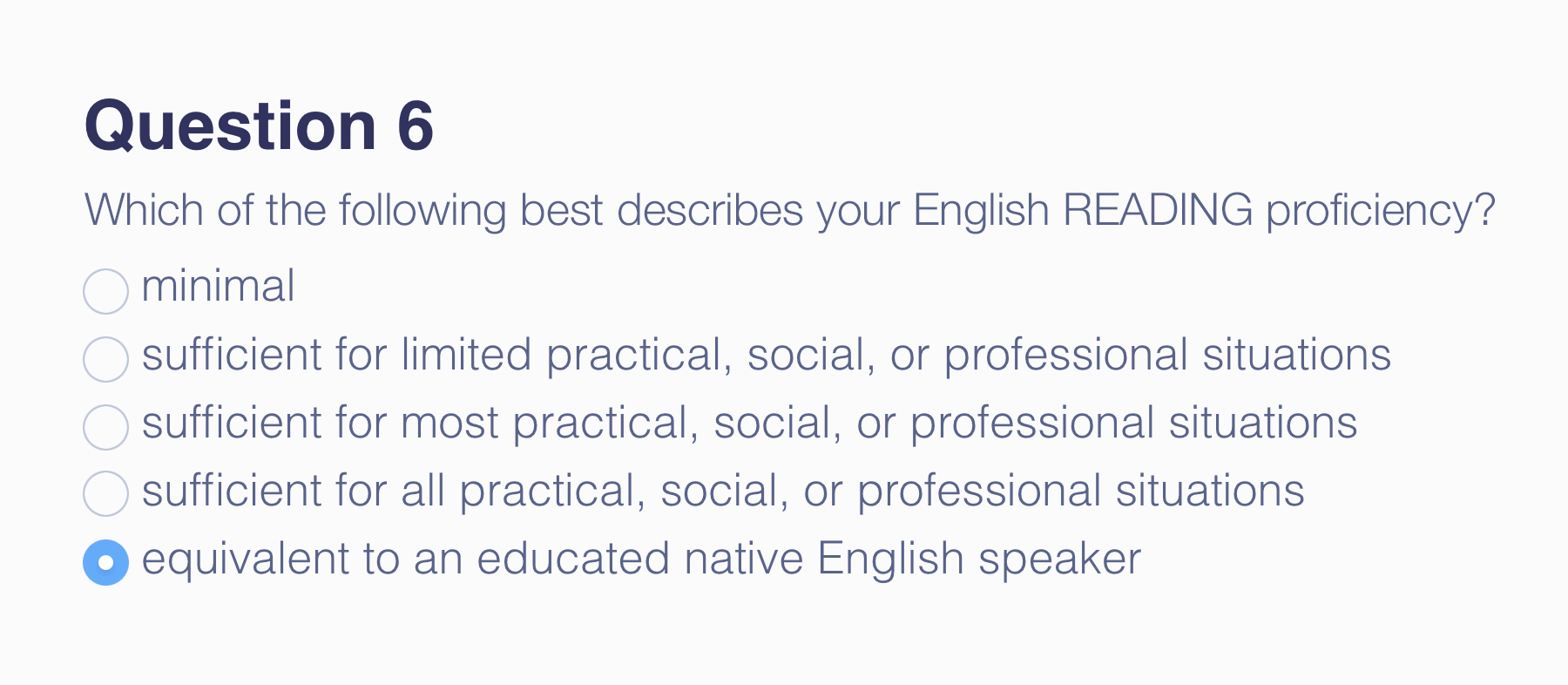
คำถามในแบบสำรวจที่ลำบากใจเป็นพิเศษ
แบบสำรวจที่ดี ซึ่งก็คือแบบสำรวจที่สร้างผลิตภัณฑ์ที่ดีขึ้นและสร้างความสัมพันธ์ที่แน่นแฟ้นยิ่งขึ้นกับผู้ใช้ จะสร้างความโดดเด่นเหนือแบบสำรวจอื่นๆ ใน 5 ด้านสำคัญ ดังนี้
- เพิ่มจำนวนผู้ที่ตอบและทำแบบสำรวจจนแล้วเสร็จ
- ทำให้การดึงข้อมูลเชิงลึกออกจากข้อมูลแบบสำรวจของคุณง่ายขึ้น
- การวิเคราะห์ข้อมูลของคุณต้องถูกต้องและแม่นยำ
- อำนวยความสะดวกให้กับการซื้อที่เกิดขึ้นจากการทำแบบสำรวจ
- เปลี่ยนวิธีที่ผู้คนมองบริษัทและแบรนด์ของคุณ
ทีมออกแบบการวิจัยแบบสำรวจและ Stripes ทั้งหมดอ้างอิงหลักการสำคัญไม่กี่ประการในการสร้างแบบสำรวจที่ดี ซึ่งได้แก่ แบบสำรวจที่ผู้ใช้จะชอบทำ ทีมงานจะชอบจะวิเคราะห์ บริษัทต่างๆ จะชอบนำไปทำตาม และบางทีอาจทำให้โลกนี้เป็นสถานที่ที่ดีขึ้นก็ได้
หลักการหลักเบื้องหลังแบบสำรวจชั้นยอด
หลักการที่ 1: ผู้คนไม่ได้ตั้งใจทำแบบสำรวจ เพื่อแบบสำรวจ
เรียกได้ว่าลูกค้าของคุณเกือบ 0% เข้าชมเว็บไซต์ของคุณเพื่อค้นหาแบบสำรวจออนไลน์ แต่พวกเขามีสิ่งอื่นอยู่ในใจ นั่นก็คือต้องการซื้อสินค้า อัปเดตการสมัครรับข้อมูลข่าวสาร ตรวจสอบแดชบอร์ด หรือเรียนรู้เพิ่มเติมเกี่ยวกับแบรนด์ของคุณ
หากจะสอดแทรกแบบสำรวจไว้ระหว่างผู้คนกับสิ่งที่พวกอยากจะทำ คุณก็ควรทำให้ประสบการณ์การทำแบบสำรวจนั้นราบรื่นที่สุดเท่าที่จะทำได้ ผู้คนไม่ควรต้องคิดมากกับการตอบคำถาม และควรสามารถกลับไปสิ่งที่ตั้งใจได้อย่างรวดเร็ว ทำให้ประสบการณ์การทำแบบสำรวจนั้นราบรื่นและเพิ่มการมีส่วนร่วมในการสำรวจด้วยแนวทางง่ายๆ ดังนี้
ทำแบบสำรวจเกี่ยวกับพวกเขา ไม่ใช่เกี่ยวกับคุณ เตือนใจพวกเขาว่าคุณจะได้รับอะไรเมื่อคุณแนะนำแบบสำรวจ อย่าขอคำติชมแบบทั่วไปแล้วถามว่า "ช่วยเราด้วยการทำแบบสำรวจนี้" บอกลูกค้าว่าคำตอบของพวกเขาจะมีประโยชน์อย่างไร ไม่ว่าจะเป็นการทำให้หน้าเว็บมีประโยชน์มากขึ้น กำจัดข้อผิดพลาด หรือให้บริการที่ดีขึ้น
เพื่อให้เข้าใจแนวคิดนี้ สมมติว่าคุณทำงานที่บริษัทท่องเที่ยวอวกาศชื่อ Rocket Rides เป้าหมายของคุณคือการสร้างประสบการณ์ที่ดีขึ้นให้กับผู้ใช้ และเพื่อให้บรรลุเป้าหมายนี้ คุณต้องเข้าใจสิ่งที่ผู้ใช้กำลังคิดอยู่ แต่เพื่อให้พวกเขาผ่านแบบสำรวจทั้งหมดได้โดยไม่ต้องหยุดและเช็ค Twitter แบบสำรวจต้องชัดเจนและน่าสนใจสำหรับผู้คน (รวมถึงมนุษย์ต่างดาวด้วย) ดังนี้
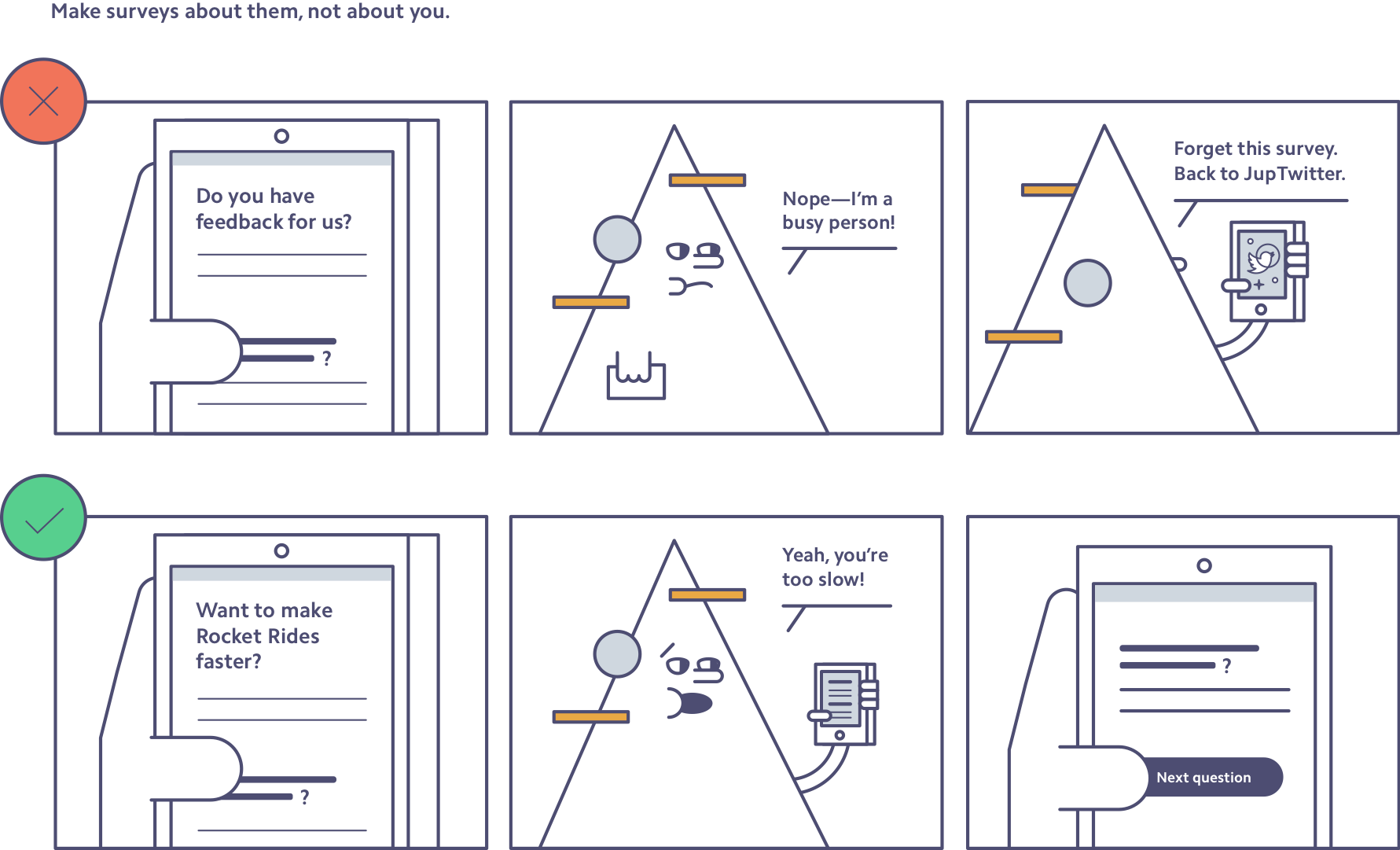
ทำให้ตัวเลือกคำตอบครอบคลุมทั้งหมด ผู้ตอบแบบสำรวจทุกคนควรสามารถตอบคำถามได้ทุกข้อ ซึ่งมักจะหมายถึงการใส่คำตอบว่า “ไม่แน่ใจ” และ “อื่นๆ (โปรดอธิบาย)” การทำเช่นนี้ไม่เพียงแต่ทำให้ผู้ตอบแต่ละคนมีสิ่งที่น่าคลิกเท่านั้น แต่ยังช่วยคัดกรองคำตอบที่ไม่เกี่ยวข้องออกไปอีกด้วย นี่คือกลยุทธ์ที่นำมาใช้ในแบบสำรวจ Rocket Rides:
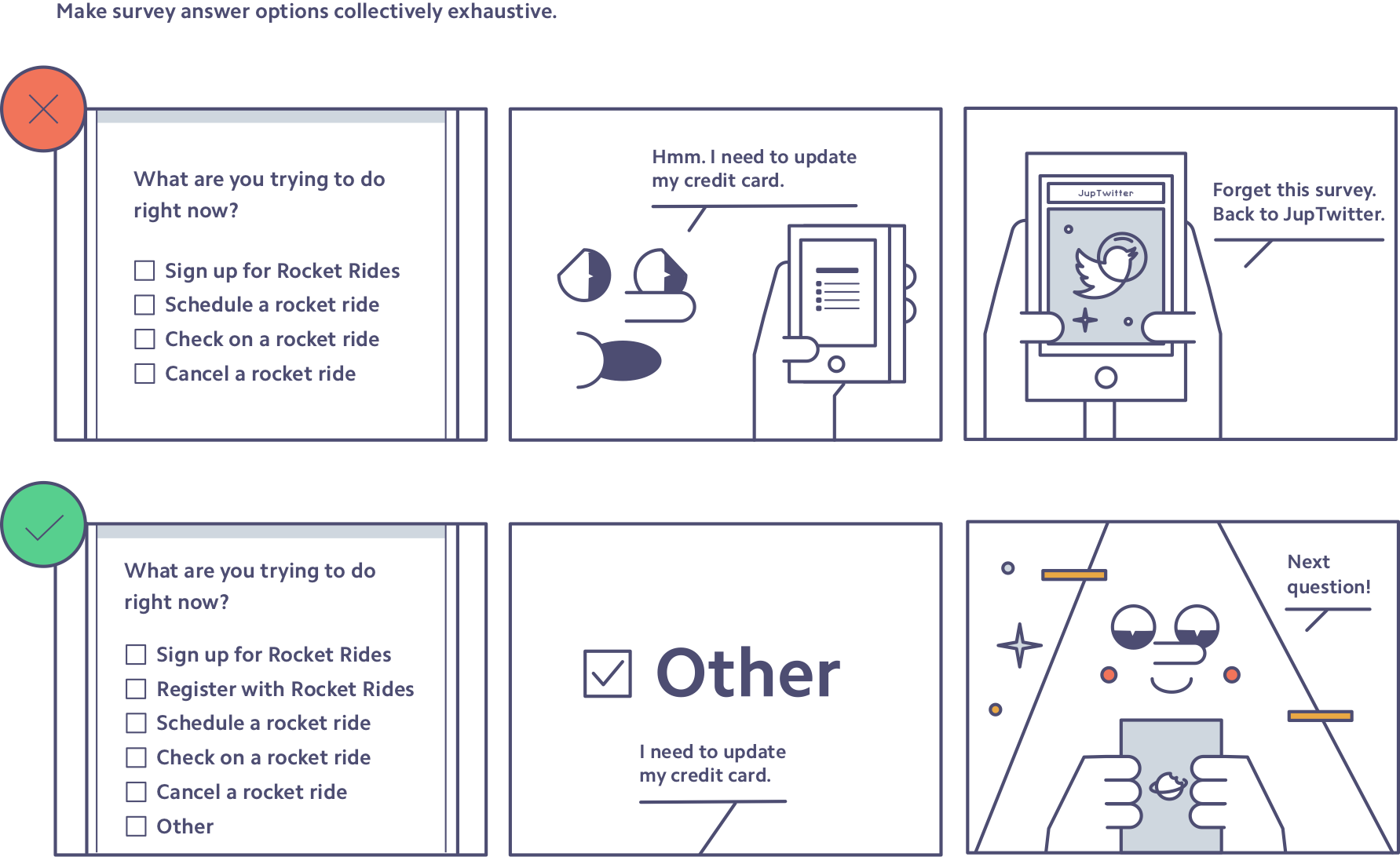
ทำให้ตัวเลือกคำตอบที่ไม่ทับซ้อนกัน เมื่อผู้ตอบแบบสำรวจเห็นตัวเลือกคำตอบที่ทับซ้อนกัน (เช่น "1-5 เที่ยว" และ "5-10 เที่ยว") ผู้ตอบจะเลิกทำแบบสำรวจกลางคัน (มีเรื่องให้คิดมากเกินไป) หรือตอบไม่ถูกต้อง ตัวเลือกคำตอบทั้งหมดต้องไม่ทับซ้อนกัน (เช่น "1-5 เที่ยว" และ "6-10 เที่ยว") เพื่อหลีกเลี่ยงความสับสนและหลีกเลี่ยงการเลิกตอบแบบสำรวจกลางคัน
เราลองมาดูกันว่า Rocket Rides จะปรับปรุงคำถามในแบบสำรวจได้อย่างไร
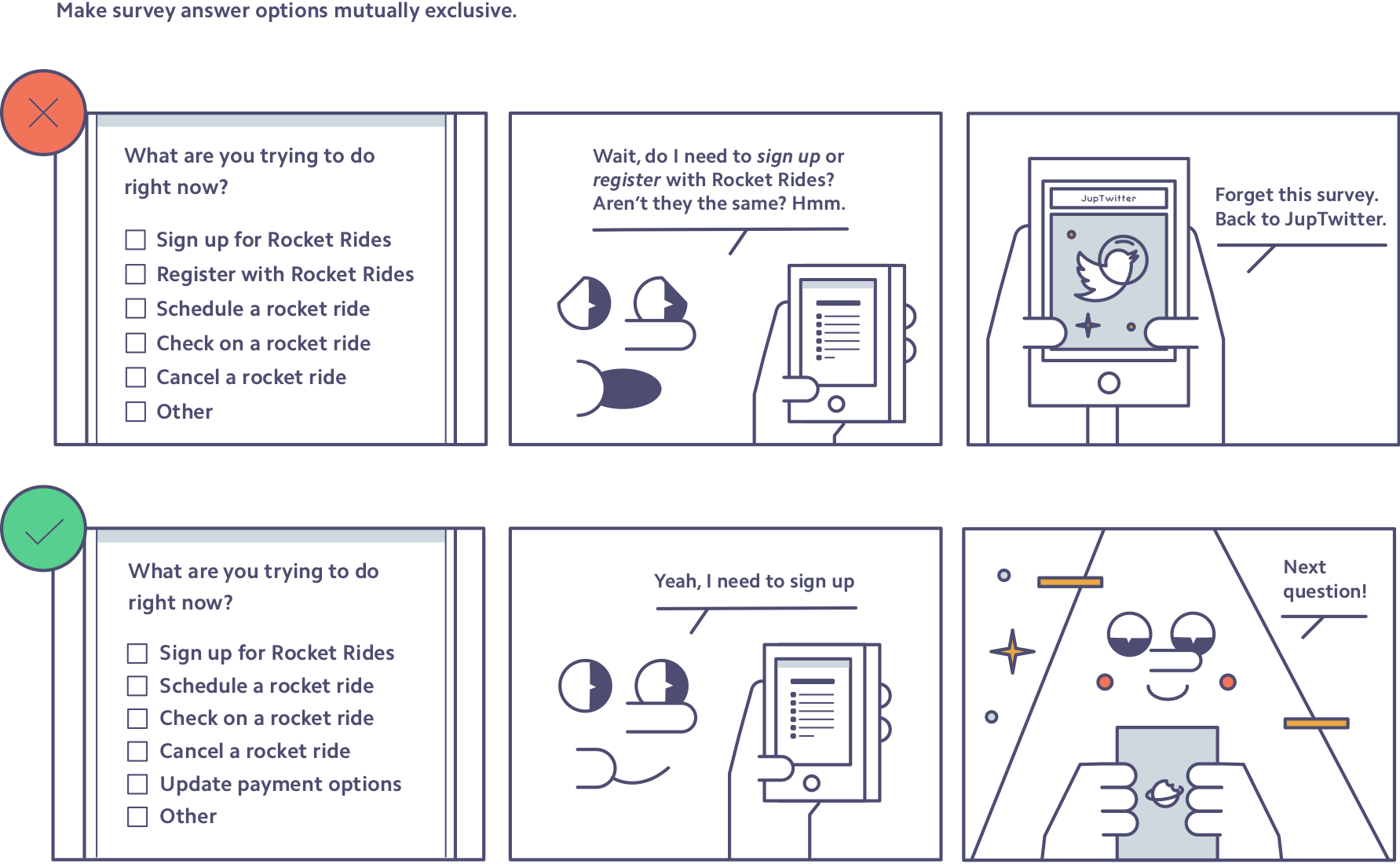
ใช้ภาษาที่ส่งเสริมให้ผู้คนแสดงความคิดเห็นส่วนตัว เมื่อขอให้ผู้คนนึกถึงหรือประเมินข้อมูล (เช่น จำนวนลูกค้า หรือจำนวนครั้งที่พวกเขาขึ้นยานอวกาศเมื่อเร็วๆ นี้) อย่าทำให้พวกเขาหยุดคิดและสงสัยว่าจำเป็นต้องมีความแม่นยำมากแค่ไหน แต่ให้ใช้คำและวลีเช่น "คร่าวๆ" "คุณคิดว่า" "โดยทั่วไป" หรือ "หากต้องเดา" แทน เพื่อให้ผู้คนสามารถตอบคำถามแบบมีความคิดเห็นส่วนตัวได้ และสามารถทำแบบสำรวจต่อได้ ลักษณะของแบบสำรวจอาจมีลักษณะดังนี้
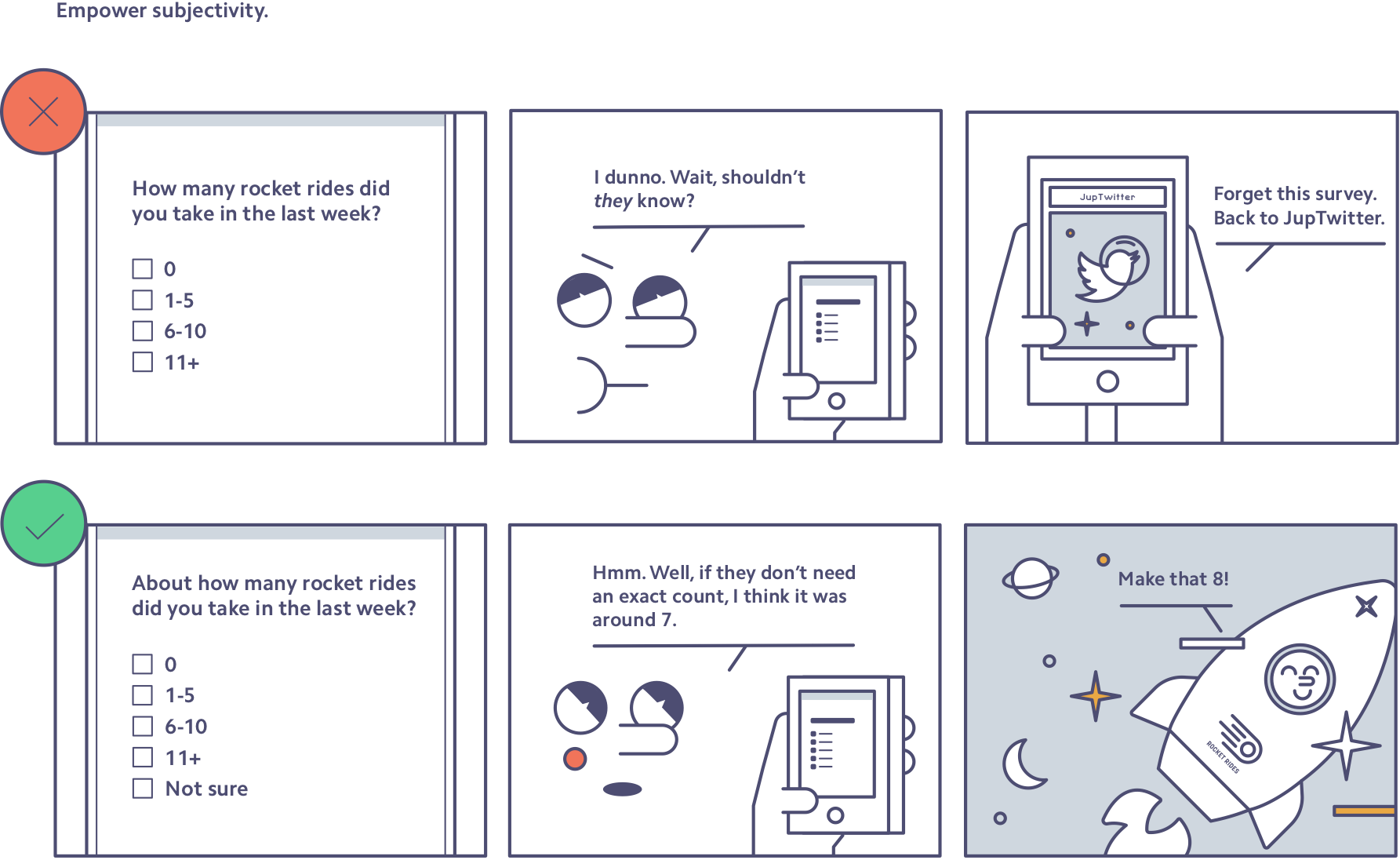
ใช้คำถามแบบตอบอิสระเพียงข้อเดียวในตอนท้ายของแบบสำรวจ คำถามแบบเลือกตอบนั้นตอบง่าย (โดยเฉพาะอย่างยิ่งหากทำตามคำแนะนำข้างต้น) แต่การคิดคำที่จะพิมพ์ลงในช่องนั้นต้องใช้ความพยายามมากกว่า โดยเฉพาะอย่างยิ่งบนมือถือ ผู้คนมีแนวโน้มที่จะเลิกทำแบบสำรวจเมื่อเจอคำถามแบบตอบอิสระ ดังนั้นจึงควรใส่คำถามเหล่านั้นไว้ในตอนท้ายของแบบสำรวจ เมื่อถึงจุดนั้น คุณได้สร้างความไว้วางใจด้วยคำถามที่สมเหตุสมผล อุ่นเครื่องผู้ตอบแบบสำรวจในหัวข้อนั้น และให้คำแนะนำเกี่ยวกับสิ่งที่คุณหวังจะได้เรียนรู้ ดังนั้น ให้ถามคำถามแบบตอบอิสระเพียงข้อเดียว และควรถาม 2 ข้อเฉพาะในโอกาสที่จำเป็นจริงๆ เท่านั้น
ต่อไปนี้คือสาเหตุที่คำถามแบบตอบอิสระมากเกินไปอาจทำให้ผู้ตอบแบบสำรวจเลิกทำกลางคัน
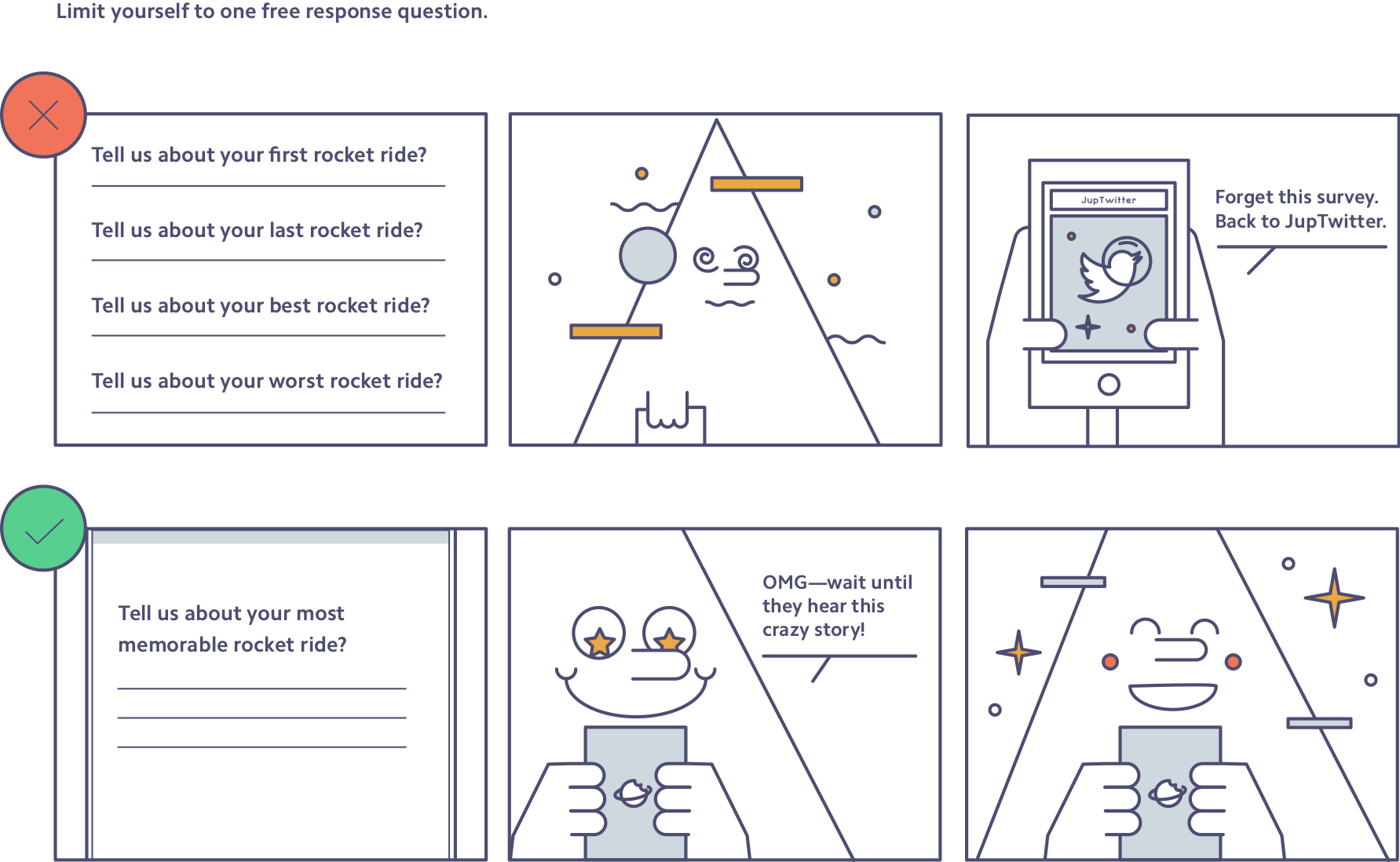
สรุป: ระหว่างการติดต่อสื่อสาร ให้กำหนดกรอบว่าแบบสำรวจที่ตอบเสร็จแล้วจะมอบประโยชน์ต่อผู้ตอบอย่างไรบ้าง ไม่ใช่ว่าจะช่วยบริษัทได้อย่างไร ให้ใช้กฎ "Mutually Exclusive, Collectively Exhaustive" หรือ "ไม่ทับซ้อนกันและครอบคลุมทั้งหมด" (MECE) เพื่อทดสอบตัวเลือกคำตอบแบบสำรวจทั้งหมด ให้ผู้ตอบมีอคติและยึดถือตัวเลขคร่าวๆ คำตอบโดยประมาณย่อมดีกว่าการเลิกทำแบบสำรวจกลางคัน เลือกคำถามแบบตอบอิสระเพียงข้อเดียว และวางไว้ท้ายแบบสำรวจเพื่อเพิ่มโอกาสในการทำแบบสำรวจจนแล้วเสร็จ
หลักการที่ 2: แบบสำรวจคือเนื้อหาที่มีแบรนด์
เมื่อผู้คนได้รับอีเมลจากบริษัทของคุณ พวกเขาไม่ได้คิดถึงคนที่ทำแบบสำรวจ แต่มองว่าแบบสำรวจเป็นการสื่อสารจากบริษัทโดยรวม แบบสำรวจคือข้อความโดยตรงถึงผู้ใช้เกี่ยวกับลำดับความสำคัญของบริษัท ความใส่ใจในรายละเอียด และการเคารพเวลาของลูกค้า ให้สร้างประสบการณ์แบบสำรวจที่ให้ความสำคัญกับเวลาของผู้ใช้ และสะท้อนถึงสิ่งที่ดีที่สุดของแบรนด์คุณ โดยคำนึงถึงเคล็ดลับเหล่านี้
ใช้มาตรฐานการเรียบเรียงเนื้อหาแบบสาธารณะ แบบสำรวจอาจถูกส่งแบบส่วนตัวพร้อมลิงก์เฉพาะ แต่ก็ยังคงเป็นเนื้อหาที่เผยแพร่สู่สาธารณะและสะท้อนถึงมาตรฐานของคุณ แบบสำรวจควรมีเครื่องหมายวรรคตอน ไวยากรณ์ การสะกดคำ ความชัดเจนของเนื้อหา และน้ำเสียงที่สมบูรณ์แบบ โดยทั่วไป วิธีเดียวที่จะมั่นใจได้คือการขอความช่วยเหลือจากผู้เชี่ยวชาญ ดังนั้นควรขอให้ผู้อื่นช่วยตรวจสอบแบบสำรวจก่อนที่จะส่งให้ผู้ใช้ ที่ Stripe เราปฏิบัติตามธรรมเนียมในการแชร์แบบสำรวจกับเพื่อนร่วมทีมก่อนจัดส่ง เพื่อช่วยตรวจจับคำผิดและประโยคที่ไม่ชัดเจน
นี่คือวิธีที่ไวยากรณ์หรือการพิมพ์ผิดแย่ๆ สามารถทำให้ผู้ตอบแบบสำรวจตกอยู่ในสถานการณ์ที่ย่ำแย่ได้
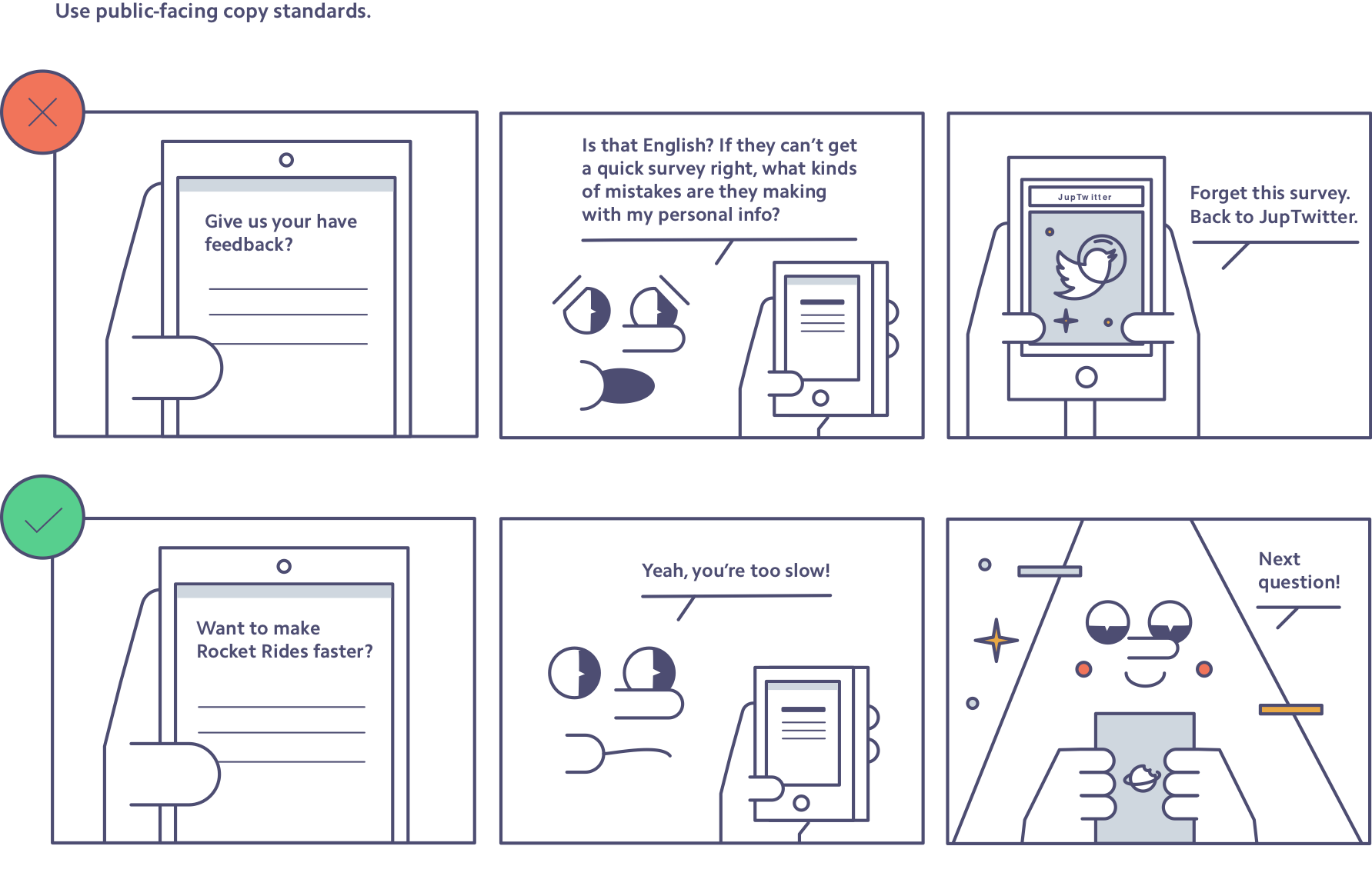
หลีกเลี่ยงการถามเกี่ยวกับหัวข้อที่ไม่เกี่ยวข้องกับผลิตภัณฑ์โดยตรง กฎง่ายๆ คือ หากไม่ถามแบบนั้นกับใครบนรถเมล์ ก็อย่าถามแบบนั้นในแบบสำรวจ หัวข้อที่อาจมีความละเอียดอ่อน ยั่วยุ และไม่มีความเกี่ยวข้องโดยตรงกับกลุ่มผลิตภัณฑ์ เช่น การเมือง ศาสนา รสนิยมทางเพศ สถานะสุขภาพ ประวัติครอบครัว และการศึกษา มักจะยากเป็นพิเศษในรูปแบบแบบสำรวจ มีวิธีถามคำถามแบบนี้ที่รอบคอบ แต่ต้องใช้ความระมัดระวังอย่างมาก ที่สำคัญที่สุดคือ ผู้ตอบแบบสำรวจต้องเข้าใจว่าทำไมคุณถึงถามคำถามส่วนตัว โดยเชื่อมโยงหัวข้อนั้นกับสิ่งที่พวกเขาสนใจอย่างชัดเจน โดยทั่วไปแล้ว ควรหลีกเลี่ยงการใส่หัวข้อเหล่านี้ เว้นแต่จะมีความสำคัญต่อความสำเร็จทางธุรกิจของคุณ (และควรปรึกษาผู้เชี่ยวชาญ เช่น ฝ่ายสื่อสารก่อน)
Rocket Rides อาจตั้งคำถามเกี่ยวกับข้อมูลประชากรได้ดังนี้
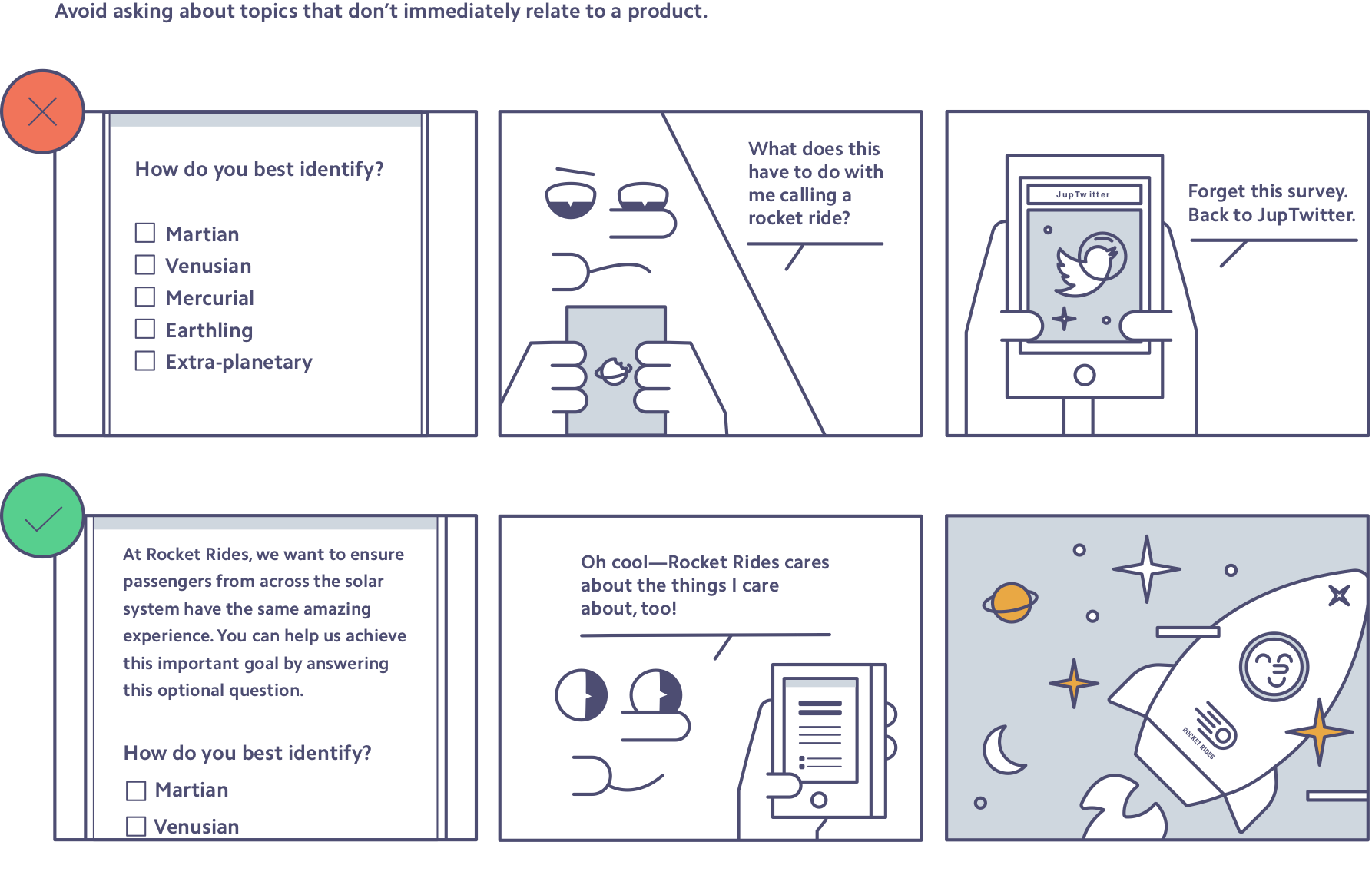
เคารพเวลาของผู้ใช้ เลือกเฉพาะคำถามที่ตรงประเด็นกับสิ่งที่คุณต้องการทราบจริงๆ คุณควรถามตัวเองว่า "คำถามนี้เคารพเวลาของผู้ใช้ไหม สะท้อนถึงลำดับความสำคัญของบริษัทเราไหม" หากแบบสำรวจของคุณยาวเกินไป ให้จัดลำดับความสำคัญของบริษัท และเลือกเฉพาะคำถามที่สะท้อนถึงลำดับความสำคัญสูงสุด 2-3 ข้อ
ทดสอบแบบสำรวจด้วยมุมมองใหม่ๆ และหลากหลาย ไม่ว่าแบบสำรวจของคุณจะเป็นความประทับใจแรกพบหรือจุดสัมผัสอื่นๆ ชื่อเสียงของแบรนด์ก็ขึ้นอยู่กับการตัดสินใจ ตรวจสอบเอกสาร เนื้อหา และความยาวของแบบสำรวจด้วยตัวคุณเอง แล้วให้คนอื่นอย่างน้อย 1 คนตรวจสอบ ผู้ตรวจสอบของคุณจะสามารถให้คำติชมเกี่ยวกับน้ำเสียงและโทนของแบบสำรวจ รวมถึงสามารถจับใจความภาษาหรือคำศัพท์ที่เข้าใจยากได้ ผู้ที่มาจากหน่วยงานอื่นของบริษัทจะดีที่สุด เพราะพวกเขาจะสามารถให้มุมมองใหม่ๆ ได้
สรุป: ให้แบบสำรวจของคุณสะท้อนถึงสิ่งที่ดีที่สุดของแบรนด์ ซึ่งหมายความว่าควรเป็นข้อความที่สาธารณชนยอมรับ ไม่เกี่ยวข้องกับหัวข้อที่ละเอียดอ่อน และให้ความสำคัญกับเวลาของผู้ใช้โดยเน้นเฉพาะประเด็นสำคัญๆ ควรฝึกทำแบบสำรวจโดยให้บุคคลอื่นเข้ามาช่วย ซึ่งอาจเป็นบุคคลในทีมสื่อสารของคุณ เนื่องจากแบบสำรวจถือเป็นเนื้อหาที่สะท้อนถึงแบรนด์
หลักการที่ 3: กำหนดและแยกแนวคิดออกจากคำถามแบบสำรวจ
ผู้ใช้ของคุณน่าจะใช้เวลาคิดเกี่ยวกับผลิตภัณฑ์ของคุณน้อยกว่าตัวคุณมาก เรามักคิดว่าผู้ตอบแบบสำรวจเข้าใจสิ่งที่เราหมายถึง ทั้งที่จริงๆ แล้วพวกเขาไม่เข้าใจเลย ดังนั้นอย่ารีบร้อนคิดไปเองว่าผู้ใช้จะเข้าใจ นี่คือวิธีที่จะทำให้พวกเขาเข้าใจและคงความเข้าใจเดียวกันกับผู้ตอบแบบสำรวจ
อธิบายแนวคิดหลักของคำถามของคุณอย่างละเอียด คำถามในแบบสำรวจแต่ละข้อควรอ้างอิงถึงหัวข้อที่ผู้ตอบสามารถระบุได้และชัดเจน ควรใช้ความระมัดระวังเมื่อแนวคิดหลักของคุณคือชื่อผลิตภัณฑ์หรือคำศัพท์ทางเทคนิค ใช้คำอธิบายหลายตัวเพื่อระบุความหมาย ตัวอย่างเช่น เมื่อ Stripe ส่งแบบสำรวจออกไป เราไม่ควรถามแค่เรื่อง "การชำระเงินออนไลน์" เราควรเพิ่มบริบทเพื่อให้ผู้ตอบแบบสำรวจเข้าใจคำถามที่ว่า "คุณรับการชำระเงินออนไลน์ (ผ่านบริษัทอย่าง Stripe, PayPal, Adyen, Braintree หรือ Square) มานานแค่ไหนแล้ว"
นี่คือตัวอย่างของการเพิ่มบริบทเพื่อให้คำถามแม่นยำและตอบได้มากขึ้น
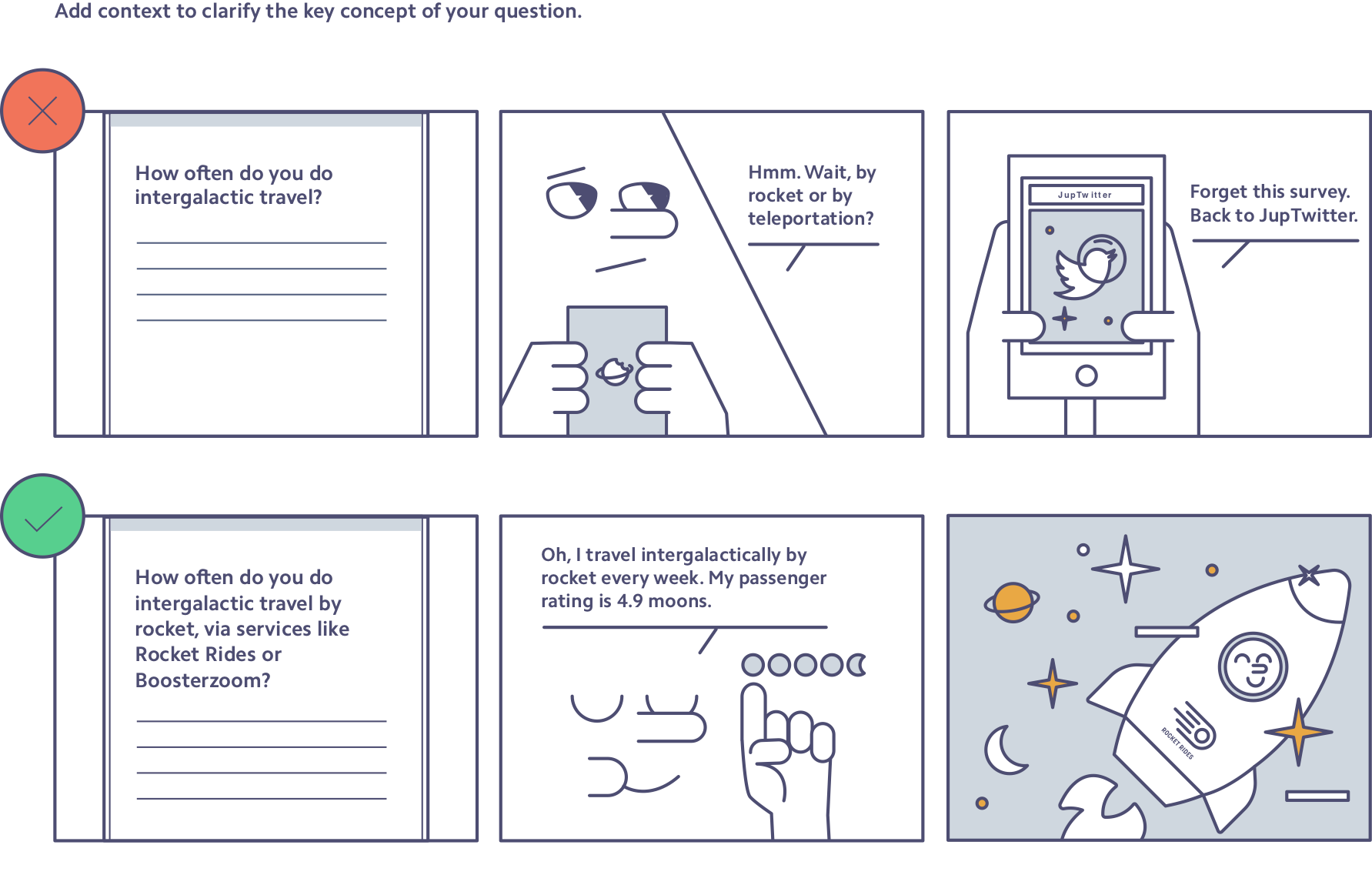
อย่าถามหลายเรื่องในคำถามเดียว การถามถึงประสบการณ์ของลูกค้าหลายๆ เรื่องพร้อมกันอาจดูดี สมมติว่าคุณอยากจะรู้ว่าประสบการณ์ของลูกค้านั้น "รวดเร็วและง่ายดาย" หรือไม่ การถามว่า "ประสบการณ์ของคุณรวดเร็วและง่ายดายแค่ไหน" ไม่เพียงแต่เป็นคำถามชี้นำ (ดูหลักการที่ 4 ด้านล่าง) แต่ผู้ตอบก็อาจตอบคำถามไม่ได้ด้วย หากประสบการณ์ของลูกค้ารวดเร็วมากแต่ไม่ง่ายเลย ลูกค้าก็ไม่รู้ว่าจะตอบยังไง อีกตัวอย่างก็คือ หากคุณต้องการประเมินว่าคู่มือนั้นเข้าใจง่ายแค่ไหน อย่าถามว่า "คู่มือนี้ให้ข้อมูลและเข้าใจง่ายแค่ไหน" แต่ให้แบ่งออกเป็น 2 เรื่องแทน คือ "คุณได้เรียนรู้สิ่งจากๆ จากคู่มือนี้มากน้อยแค่ไหน" และ "คู่มือนี้ชัดเจนหรือไม่ชัดเจนแค่ไหน" การไม่ใส่เรื่องหลายเรื่องไว้ในคำถามเดียวจะช่วยให้ผู้ใช้ทำแบบสำรวจได้ง่ายขึ้น ข้อมูลของคุณก็จะเข้าใจง่ายขึ้นมาก
กลยุทธ์ที่ Rocket Rides ใช้จริงเมื่อทำแบบสำรวจมีดังนี้
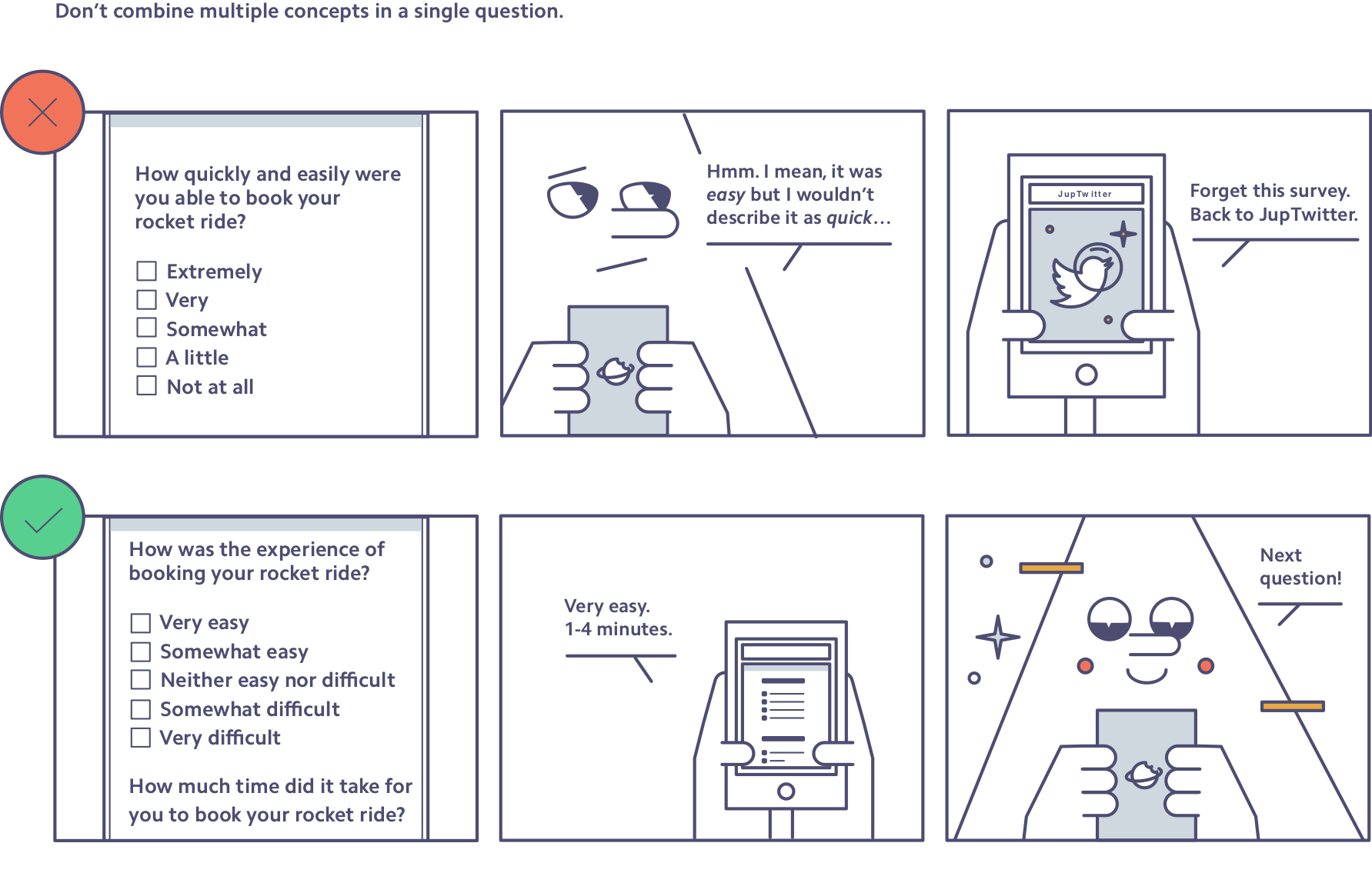
เจาะจงเข้าไว้เพราะทุกอย่างเกี่ยวข้องกันหมด การใช้คำศัพท์ที่เกี่ยวข้องกันมักก่อให้เกิดการรวบรวมข้อมูลผิดๆ โดยไม่ได้ตั้งใจ คำว่า "บ่อย" ของคุณกับของผู้ใช้อาจแตกต่างกันโดยสิ้นเชิง คุณอาจมองว่า "บ่อย" คือ "หลายครั้งในแต่ละวัน" แต่ผู้ใช้อาจคิดว่า "สัปดาห์ละครั้ง" หาวิธีระบุคำตอบให้เฉพาะเจาะจงมากๆ เพื่อให้คุณรู้ว่าควรดำเนินการอย่างไรต่อไป
ต่อไปนี้คือวิธีที่ Rocket Rides อาจปรับปรุงคำถามแบบสำรวจและข้อมูลที่ได้รับจากผู้ใช้
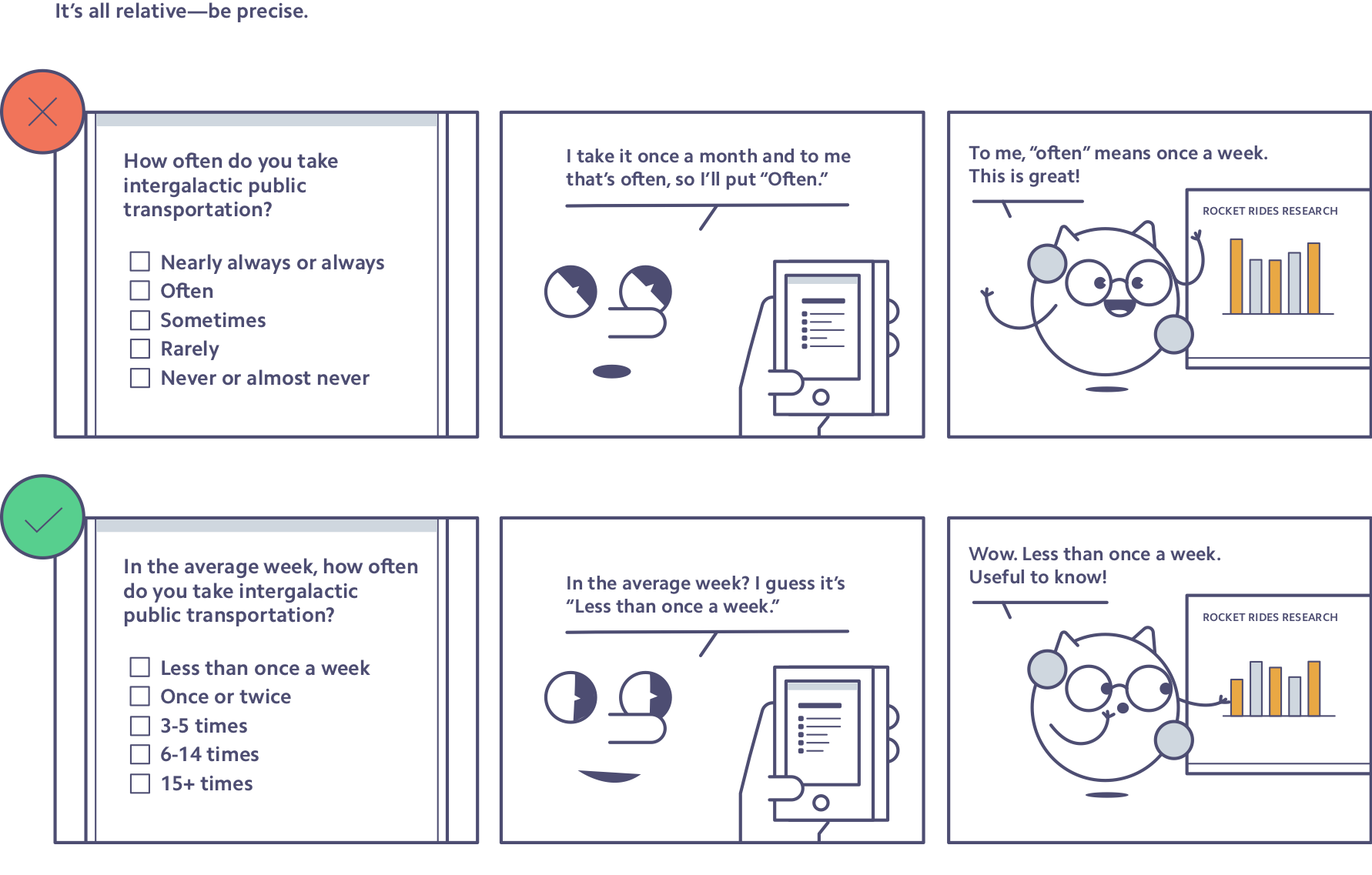
สรุป: ปัญหาส่วนใหญ่มักเกิดจากความซับซ้อนและความกำกวม คนทำแบบสำรวจมักติดกับดักง่ายๆ เช่น ชื่อผลิตภัณฑ์หรือศัพท์เทคนิค คำถามที่เห็นด้วยหรือไม่เห็นด้วย คำศัพท์ที่ตีความได้ เช่น "บ่อยครั้ง" หรือ "บางครั้ง" หรือคำอธิบายประกอบ เช่น "รวดเร็วและง่ายดาย" ดังนั้น เมื่อมีข้อสงสัย ให้ตั้งคำถามกับสมมติฐานและอธิบายให้ชัดเจน คุณเลี่ยงกับดักมากมายได้ด้วยการให้บริบท การอธิบายภาษาให้ชัดเจน หรือการแยกแนวคิดออกจากกัน
หลักการที่ 4: ความน่าพอใจที่ลดลง
วิทยาศาสตร์บอกว่าคนเรามักจะบอกสิ่งที่คุณคิดว่าคุณอยากได้ยิน ซึ่งนั่นเป็นปัญหา เพราะคุณต้องได้รับคำติชมอย่างตรงไปตรงมาเพื่อสร้างผลิตภัณฑ์ที่ดีที่สุด เคล็ดลับเหล่านี้จะช่วยให้ผู้ใช้กล้าพูดความจริงเมื่อสิ่งต่างๆ ไม่เป็นไปตามที่คาดหวัง
แก้ไขคำถามชี้นำ เมื่อถามผู้ตอบแบบสอบถามว่าพวกเขาคิดว่าสิ่งใดเป็นไปในเชิงบวก (หรือมีประโยชน์ ดี หรือถูกต้อง) มากน้อยเพียงใด คุณจะกระตุ้นให้พวกเขาคิดในแง่บวก และชี้นำให้พวกเขาตอบในเชิงบวกมากขึ้น พฤติกรรมนี้จะซับซ้อนมากขึ้นเมื่อเป็นเรื่องระหว่างประเทศ เนื่องจากการวิจัยแบบสำรวจแสดงให้เห็นว่าแต่ละภูมิภาคตอบคำถามในแบบสำรวจด้วยวิธีที่แตกต่างกัน ตัวอย่างเช่น ในบางประเทศ (เช่น ฝรั่งเศส กรีซ และอินเดีย) ผู้คนมีแนวโน้มที่จะเลือกตัวเลือกที่เป็นกลาง (หรือตรงกลาง) น้อยกว่า และมีแนวโน้มที่จะตอบด้วยตัวเลือกที่รุนแรงกว่า ในพื้นที่อื่นๆ เช่น ยุโรปเหนือ ผู้คนมีแนวโน้มที่จะตอบในเชิงบวกน้อยกว่าโดยเฉลี่ย ซึ่งหมายความว่าการเปรียบเทียบผลการสำรวจระหว่างสองประเทศอาจเป็นเรื่องยาก การสร้างคำถามโดยไม่ใช้คำชี้นำอย่างระมัดระวังสามารถช่วยขจัดความคลาดเคลื่อนเหล่านั้นในตลาดต่างๆ และไม่ว่าจะอย่างไรก็ตาม ถือเป็นแนวทางปฏิบัติที่ดีที่สุด
ต่อไปนี้เป็นรายการคำถาม ซึ่งแสดงระดับจากคำถามชี้นำอย่างเปิดเผยไปจนถึงคำถามที่เป็นกลางและไม่ชี้นำ
- แบบสำรวจนี้ดีเพียงใด
- คุณชอบแบบสำรวจนี้มากแค่ไหน
- คุณจะแนะนำแบบสำรวจนี้บ่อยแค่ไหน
- คุณจะแนะนำแบบสำรวจนี้ไหม
- คุณให้คะแนนแบบสำรวจนี้มากน้อยแค่ไหน
Rocket Rides อาจปรับกรอบคำถามนำใหม่ได้ดังนี้
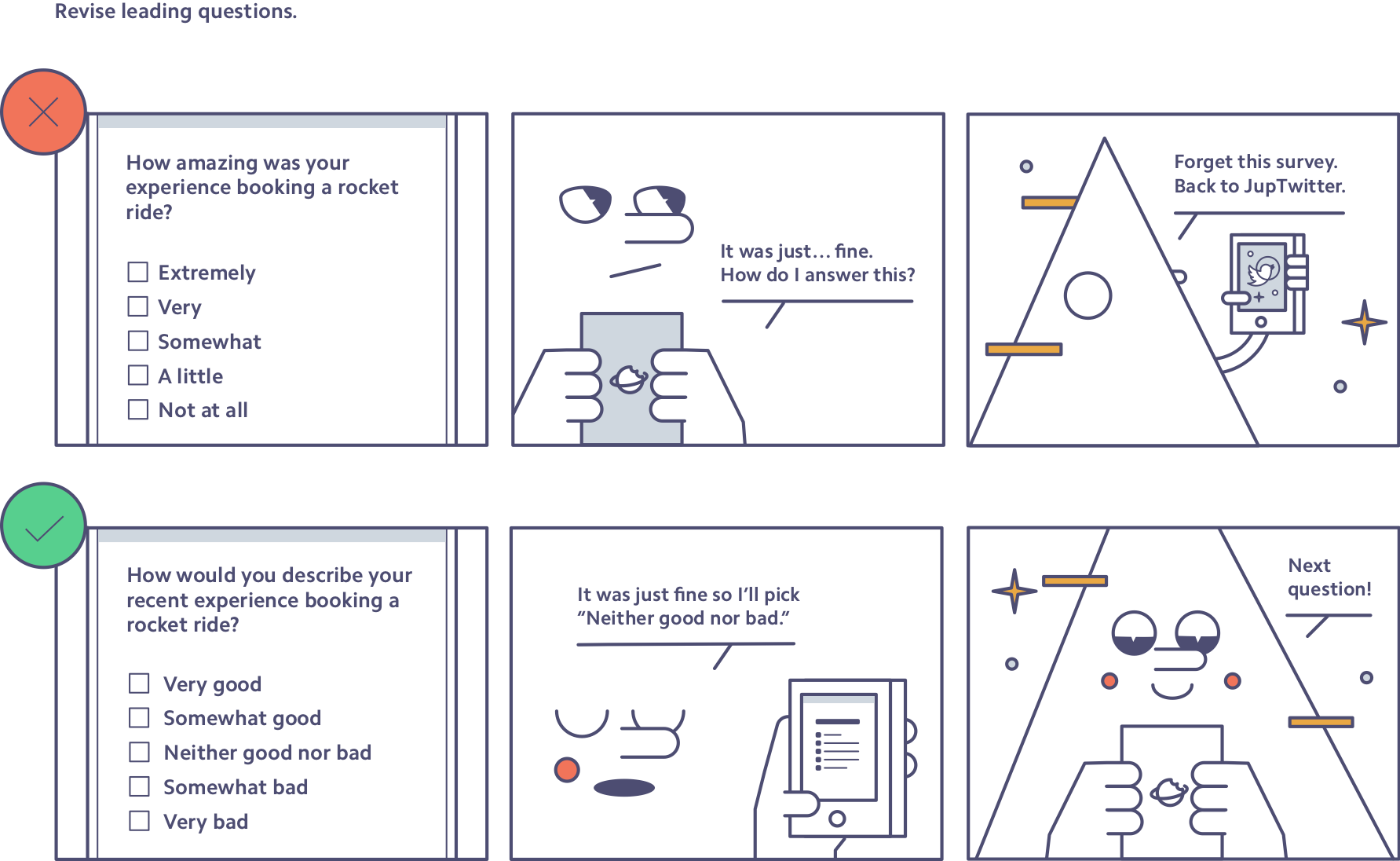
หลีกเลี่ยงมาตราส่วนเห็นด้วย-ไม่เห็นด้วย คำถามที่ใช้มาตราส่วนเห็นด้วย-ไม่เห็นด้วย ซึ่งก็คือมีตัวเลือกตั้งแต่เห็นด้วยอย่างยิ่งไปจนถึงไม่เห็นด้วยอย่างยิ่ง มักก่อให้เกิดอคติแบบคล้อยตาม ซึ่งก็คือการพูดเกินจริงที่ทำให้ผู้คนตอบคำถามเชิงบวกหรือเห็นด้วยบ่อยขึ้น แม้ว่าจะมีบางกรณีที่มาตราส่วนเห็นด้วย-ไม่เห็นด้วยนั้นใช้ได้ผลดี ซึ่งโดยทั่วไปก็คือตอนที่คำถามนั้นเรียบง่ายและชัดเจนมากๆ แต่คำตอบเฉพาะประเด็นจะดีกว่า 95% ซึ่งคำตอบเฉพาะประเด็นหมายถึงการที่คำตอบในแบบสำรวจมีความสอดคล้องกับคำถามของแบบสำรวจ ดังนั้น แทนที่ผู้ตอบต้องระบุว่าเห็นด้วยหรือไม่เห็นด้วยกับข้อความ ผู้ตอบก็มีโอกาสได้อธิบายว่ารู้สึกอย่างไรกับข้อความนั้นๆ หรือตอบว่าทำสิ่งนั้นๆ บ่อยแค่ไหน
วิธีที่ Rocket Rides อาจจะเปลี่ยนคำถามโดยใช้มาตราส่วนเห็นด้วย-ไม่เห็นด้วยมีดังนี้

รับฟังคนที่ไม่เห็นด้วย กำหนดน้ำเสียงของความคิดเห็นและความเต็มใจที่จะเรียนรู้ตั้งแต่แรกๆ โดยแจ้งให้ผู้ใช้ทราบว่าคุณต้องการความคิดเห็นที่ตรงไปตรงมาในหน้าบทนำหรือย่อหน้า ผลการศึกษาแสดงให้เห็นว่าการขอความคิดเห็นที่ตรงไปตรงมาตั้งแต่เริ่มแบบสำรวจสามารถกระตุ้นให้เกิดการตอบแบบสำรวจที่รอบคอบมากขึ้น ลองขอความคิดเห็นจากผู้ใช้โดยใช้ช่องแสดงความคิดเห็นอิสระ แม้ว่าพวกเขาจะเคยบอกไปแล้วว่าชอบผลิตภัณฑ์หรือประสบการณ์ของคุณก็ตาม นี่เป็นอีกวิธีหนึ่งที่แสดงให้เห็นว่าคุณต้องการรับฟังอย่างแท้จริงว่าคุณสามารถปรับปรุงสิ่งต่างๆ ให้ดีขึ้นได้อย่างไร นอกจากนี้ยังสามารถรวบรวมความคิดเห็นจากผู้ที่อาจได้รับอิทธิพลจากอคติแบบคล้อยตาม
สรุป: กระตุ้นให้ผู้ใช้พูดความจริงใจและตรงไปตรงมา เริ่มต้นแบบสำรวจโดยบอกผู้ตอบแบบสอบถามว่าคุณต้องการให้ตอบคำถามอย่างตรงไปตรงมา และเปิดโอกาสให้ได้รับความคิดเห็นตอนจบแบบสำรวจ ตัดทอนหรือแก้ไขคำถามชี้นำ ระวังอย่าใช้คำพูดเชิงบวกหรือมาตราส่วนเห็นด้วย-ไม่เห็นด้วยเพื่อโน้มน้าวผู้ตอบแบบสอบถาม
บทบาทของแบบสำรวจออนไลน์ที่ถูกมองข้าม
แบบสำรวจเปรียบเสมือนกระจกสะท้อนภาพลักษณ์ของบริษัทที่ส่งแบบสำรวจนั้นๆ ผู้คนอาจยินดีกับโอกาสในการมีปฏิสัมพันธ์ สนับสนุน และพัฒนาแบรนด์ของคุณ และร่วมตอบแบบสำรวจ หรือผู้ตอบอาจปฏิเสธเพราะมองว่าเป็นเรื่องกวนใจ ไม่สนใจ หรือไม่ไว้ใจ ไม่ว่าผลตอบรับเบื้องต้นจะเป็นอย่างไร ภารกิจก็ยังคงเหมือนเดิม ซึ่งก็คือการรับฟังความคิดเห็นเพื่อปรับปรุงผลิตภัณฑ์ให้ตอบโจทย์ความต้องการของผู้คนได้ดียิ่งขึ้น
แบบสำรวจจะก้าวหน้าก็ต่อเมื่อกระจกที่ว่าสะท้อนภาพของผู้ตอบ ไม่ใช่ตัวบริษัทเอง ยิ่งผู้ตอบแบบสำรวจได้รับความสนใจมากเท่าใดก็ยิ่งดีเท่านั้น โดยการเปลี่ยนแปลงนี้จะเกิดขึ้นเมื่อ
- คำถามในแบบสำรวจไม่ชวนให้ปวดหัวไปเสียทุกข้อ จากตัวเลือกคำตอบที่ไม่ทับซ้อนกันและครอบคลุมทั้งหมด ไปจนถึงการวางคำถามแบบให้ตอบอิสระ
- ผู้คนออกแบบ ร่างแบบ และมองว่าแบบสำรวจเป็นเนื้อหาของแบรนด์
- คำถามในแบบสำรวจประกอบไปด้วยบริบท กำหนดเงื่อนไขที่คลุมเครือและแยกแนวคิดออกจากกัน
- แบบสำรวจช่วยให้ผู้ตอบแบบสอบถามสามารถแสดงความคิดเห็นที่ไม่เห็นด้วยและแบ่งปันความคิดเห็นที่ตรงไปตรงมา
Stripes ได้สำรวจความคิดเห็นผู้ใช้มาตั้งแต่แรกเริ่ม แต่ก็ยังคงอยู่ระหว่างการพัฒนา ทีมวิจัยแบบสำรวจของเรายังคงพัฒนาวิธีการจัดเตรียมเครื่องมือสำหรับพนักงานทุกคนในการร่างและใช้งานแบบสำรวจ ควบคู่ไปกับการทำให้มั่นใจว่าผู้ใช้จะได้รับประสบการณ์ที่ดีจากการตอบแบบสำรวจ ผลลัพธ์ที่เราต้องการคือความสมดุล นั่นคือการนำเสนอ Stripe ด้วยน้ำเสียงที่ตรงไปตรงมาและอบอุ่นผ่านแบบสำรวจ ขณะเดียวกันก็ทำให้ทุกคนสามารถแบ่งปันความคิดเห็นและสนับสนุนธุรกิจของพวกเขาต่อไปได้อย่างราบรื่น
ความสมดุลที่ว่านี้เป็นเรื่องที่ท้าทาย แต่ผลลัพธ์ที่ได้ก็คุ้มค่า
บอกเราหน่อยว่าคุณเคยลอง หรือจะลองกลยุทธ์เหล่านี้ หรือมีเคล็ดลับเกี่ยวกับแนวทางปฏิบัติที่ดีที่สุดในการออกแบบแบบสำรวจหรือไม่ เรายินดีรับฟังทุกความคิดเห็น ส่งอีเมลมาหาเราได้ที่ research@stripe.com หรือหากต้องการร่วมงานกับเราและพัฒนางานวิจัยที่ Stripe โปรดสมัครที่นี่
